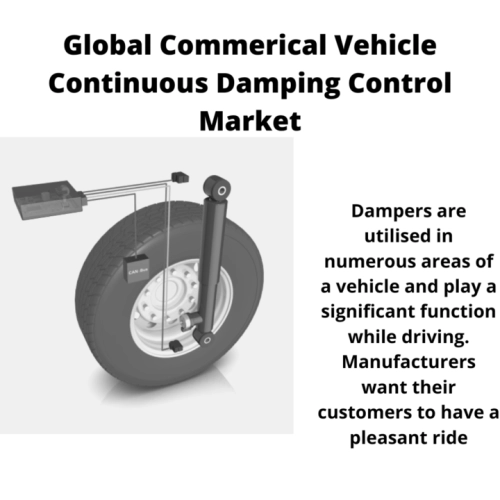
- Get in Touch with Us

Last Updated: Apr 25, 2025 | Study Period: 2024-2030
A shock absorber is a mechanical or hydraulic device that absorbs and dampens shock impulses. It accomplishes this by changing the shock's kinetic energy into another source of power, which is then dispersed. Since its conception, automotive suspension has developed, with more attention now being paid to dampers.
Dampers are utilised in numerous areas of a vehicle and play a significant function while driving. Manufacturers want their customers to have a pleasant ride. The differential action can be achieved by resisting both strokes while the damper causes a stronger action on the rebound.

The CDC system is capable of self-diagnosis; however it only recognises electrical problems, not mechanical ones. The CDC control lighting on the dashboard illuminates when there is a problem.
In today's vehicles, more automakers are opting for the Continuous Damping Control (CDC) system, which uses a continually changing damping mechanism. It constantly monitors "influencing" parameters such road conditions, load, vehicle body acceleration, and the actions of the driver.
Only tighten the bottom fastening screws when the car is standing on its wheels to avoid tension or strain on the dampers. The wheel geometry is then measured and, if necessary, readjusted. The proportional valve adjusts the damping force for each wheel in milliseconds.
Improved road contact provides better ride comfort and dynamics, reduced rolling and pitching action, and shorter braking distance. These are advantages that are increasingly being used in applications such as buses, coaches, trucks, and agricultural gear.
The mechanical damper's strength is increased as the velocity of spring displacement increase. In the next two to four years, the dampers industry is likely to be propelled by increased daily travel durations due to global city expansion and the need to ride smoothly to decrease jerks on uneven surfaced roads.
Due to the lack of a gas separator piston to separate gas from oil, the gas and oil may mix, lowering the damping force and resulting in expensive replacement and maintenance costs.
ZF is a leading mobiliser of the roof airbag modules in the market. The latest integration has been employing vehicle data given by sensors, a central control unit determines the ideal damping forces for each individual wheel.
Within a spectrum of curves spanning hard/safety-oriented to soft/comfort-oriented, this CDC system sets the ideal damping in compression and rebounding. Depending upon that customer's requirement, the valve system can be used to change vehicle-specific characteristics. The body acceleration sensors are now integrated within the ECU rather than being on the outside.
GM is part of the component manufacture trending companies in the current industry. The spectrum of characteristic curves, from hard/safety-oriented to soft/comfort-oriented, the system regulates compression and rebound to give optimum damping.
The damping programme generated by the ECU is then delivered to each damper, where the damping needs are carried out by the valves within the damper with the entire process (loop) requiring less than two milliseconds.
It provides a higher level of safety thanks to improved wheel dampening, which improves driving comfort and dynamics, such as during lane changes.
| Sl no | Topic |
| 1 | Market Segmentation |
| 2 | Scope of the report |
| 3 | Abbreviations |
| 4 | Research Methodology |
| 5 | Executive Summary |
| 6 | Introduction |
| 7 | Insights from Industry stakeholders |
| 8 | Cost breakdown of Product by sub-components and average profit margin |
| 9 | Disruptive innovation in the Industry |
| 10 | Technology trends in the Industry |
| 11 | Consumer trends in the industry |
| 12 | Recent Production Milestones |
| 13 | Component Manufacturing in US, EU and China |
| 14 | COVID-19 impact on overall market |
| 15 | COVID-19 impact on Production of components |
| 16 | COVID-19 impact on Point of sale |
| 17 | Market Segmentation, Dynamics and Forecast by Geography, 2024-2030 |
| 18 | Market Segmentation, Dynamics and Forecast by Product Type, 2024-2030 |
| 19 | Market Segmentation, Dynamics and Forecast by Application, 2024-2030 |
| 20 | Market Segmentation, Dynamics and Forecast by End use, 2024-2030 |
| 21 | Product installation rate by OEM, 2023 |
| 22 | Incline/Decline in Average B-2-B selling price in past 5 years |
| 23 | Competition from substitute products |
| 24 | Gross margin and average profitability of suppliers |
| 25 | New product development in past 12 months |
| 26 | M&A in past 12 months |
| 27 | Growth strategy of leading players |
| 28 | Market share of vendors, 2023 |
| 29 | Company Profiles |
| 30 | Unmet needs and opportunity for new suppliers |
| 31 | Conclusion |
| 32 | Appendix |